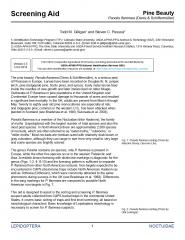Bloom Color: Yellow. Main Bloom Time: Early spring, Late spring, Mid spring. Form: Oval, Pyramidal.
Pinus sylvestris is an evergreen Tree growing to 25 m by 10 m at a fast rate.
It is hardy to zone 2. It is in leaf all year, in flower in May, and the seeds ripen from March to June. The species is monoecious and is pollinated by Wind. The plant is not self-fertile.
It is noted for attracting wildlife.
Suitable for: light and medium soils, prefers well-drained soil and can grow in nutritionally poor soil. Suitable pH: acid, neutral and basic soils and can grow in very acid and very alkaline soils.
It can grow in semi-shade or no shade. It prefers dry moist or wet soil and can tolerate drought. The plant can tolerate maritime exposure.
It can tolerate atmospheric pollution.
Industrial Crop: Hydrocarbon Management: Standard Regional Timber
Landscape Uses:Christmas tree, Specimen. Thrives in a light well-drained sandy or gravelly loam. Trees grow well on poor dry sandy soils. Fairly shade tolerant. Prefers a light acid soil, becoming chlorotic at a pH higher than 6.5. Trees can succeed for many years on shallow soils over chalk. Tolerates chalk for a while, but trees are then short-lived. Tolerates some water-logging. Dislikes poorly drained moorland soils. Established plants tolerate drought. Very wind resistant, tolerating maritime exposure. Tolerates atmospheric pollution. Fairly long-lived, to 200 years or more and quite fast growing, but trees are very slow growing in wet soils. Young trees can make new growth of 1 metre a year though growth slows down rapidly by the time the tree is 18 metres tall. This species is extensively used in cool temperate forestry as a timber tree. Plants are strongly outbreeding, self-fertilized seed usually grows poorly. They hybridize freely with other members of this genus. Cones take two seasons to ripen. Plants are easily killed by fire and cannot regenerate from the roots. A good food plant for the caterpillars of several species of butterflies. This tree has over 50 species of associated insects. Leaf secretions inhibit the germination of seeds, thereby reducing the amount of plants that can grow under the trees. There are several named forms selected for their ornamental value. Plants in this genus are notably susceptible to honey fungus. Special Features:
Not North American native, Naturalizing, Inconspicuous flowers or blooms.
HabitatsWoodland Garden Canopy
HabitatsBog Garden
HabitatsWoodland Garden Canopy
HabitatsBog Garden
Resources
dendrolimus

United States
Department of
Agriculture
Animal and
Plant Health
Inspection
Service
Plant Protectionhttp://www.aphis.usda.gov/import_export/plants/manuals/emergency/downloads/dend…dendrolimusdendrolimus
United States
USDA APHIShttp://www.aphis.usda.gov/import_export/plants/manuals/emergency/downloads/dend…
Department of
Agriculture
Animal and
Plant Health
Inspection
Service
Plant Protection
and Quarantine New Pest Responsedendrolimus
United States
USDA APHIShttp://www.aphis.usda.gov/import_export/plants/manuals/emergency/downloads/dend…
Department of
Agriculture
Animal and
Plant Health
Inspection
Service
Plant Protection
and Quarantine New Pest ResponsePanolis flammea high

1
Screening Aid
The pine beauty, Panolis flammea (Denis & Schiffermüller), is a serious pesthttp://idtools.org/screeningaids/leps/high/Panolis_flammea_high.pdfPanolis flammea highPanolis flammea high
1
ITPhttp://idtools.org/screeningaids/leps/high/Panolis_flammea_high.pdf
Screening Aid
The pine beauty, Panolis flammea (Denis & Schiffermüller), is a serious pestPanolis flammea high
1
ITPhttp://idtools.org/screeningaids/leps/high/Panolis_flammea_high.pdf
Screening Aid
The pine beauty, Panolis flammea (Denis & Schiffermüller), is a serious pest
Major pests
- Acantholyda posticalis
Agrotis segetum
Armillaria ostoyae
Bursaphelenchus xylophilus
Candidatus Phytoplasma pini
Chionaspis pinifoliae
Cronartium comandrae
Cronartium comptoniae
Cronartium flaccidum
Cronartium quercuum
Cyclaneusma minus
Dendrolimus tabulaeformis
Diprion pini
Diprion similis
Endocronartium harknessii
Eulachnus rileyi
Fomitopsis pinicola
Gremmeniella abietina
Heterobasidion annosum
Hylastes ater
Hylobius abietis
Hylotrupes bajulus
Hylurgops palliatus
Hylurgus ligniperda
Ips grandicollis
Ips hauseri
Ips pini
Ips sexdentatus
Leptographium wingfieldii
Lymantria monacha
Melampsora populnea
Monochamus carolinensis
Monochamus galloprovincialis
Monochamus sutor
Mycosphaerella dearnessii
Mycosphaerella gibsonii
Mycosphaerella pini
Neodiprion sertifer
Ophiostoma piceae
Orthotomicus erosus
Pineus pini
Pissodes castaneus
Pissodes piniphilus
Pissodes validirostris
Rhyacionia frustrana
Schizolachnus pineti
Sirococcus conigenus
Sphaeropsis sapinea
Sphinx pinastri
Tetropium gracilicorne
Thaumetopoea pityocampa
Thecodiplosis brachyntera
Tomicus minor
Tomicus piniperda
Trypodendron lineatum
Xylosandrus germanus
Minor pests
- Atropellis pinicola
Bursaphelenchus mucronatus
Choristoneura pinus pinus
Cinara nigritergi
Coleosporium asterum
Crumenulopsis sororia
Dendroctonus micans
Dendroctonus ponderosae
Elatobium abietinum
Gibberella avenacea
Gibberella circinata
Gibberella zeae
Heterobasidion annosum sensu lato
Heterobasidion parviporum
Ips duplicatus
Ips subelongatus
Ips typographus
Leptographium procerum
Leptosphaeria coniothyrium
Lymantria dispar
Melolontha melolontha
Pineus boerneri
Pissodes nemorensis
Pissodes strobi
Pityogenes chalcographus
Pityokteines curvidens
Rhizosphaera kalkhoffii
Rhyacionia buoliana
Sirex noctilio
Sydowia polyspora
Tetropium castaneum
Thaumetopoea processionea
Thecodiplosis japonensis
Xiphinema americanum
